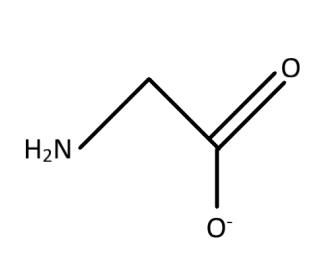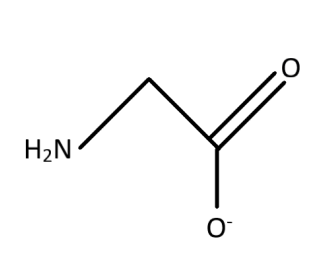
Glycinato ligand is:
A.

B. Bidentate ligand
C. Two donor sites
D. All of the above

Answer
456k+ views
Hint: The ligand which forms a bonded structure or interacts with a metal ion depends on the presence of a lone pair of electrons in the ligand structure. The lone pair fills the vacant orbitals of the metal ion which is responsible for the formation of the complex.
Complete step by step solution:
The structure of the glycinato ligand is considered as the ligand form of glycinate. The structure of glycinate is formed with a central carbon associated with amino

The ligand is bidentate as there are two sites from which the electron pairs can be shared with the metal ions for the association. The oxygen residue in the
Note:
The ligand has the specific property of getting associated with the metal ion based on the nature of the electron sharing. The differences in the type of ligand cause changes in the geometry of the complex that is formed with the metal ion.
Complete step by step solution:
The structure of the glycinato ligand is considered as the ligand form of glycinate. The structure of glycinate is formed with a central carbon associated with amino

The ligand is bidentate as there are two sites from which the electron pairs can be shared with the metal ions for the association. The oxygen residue in the
Note:
The ligand has the specific property of getting associated with the metal ion based on the nature of the electron sharing. The differences in the type of ligand cause changes in the geometry of the complex that is formed with the metal ion.
Latest Vedantu courses for you
Grade 10 | CBSE | SCHOOL | English
Vedantu 10 CBSE Pro Course - (2025-26)
School Full course for CBSE students
₹37,300 per year
Recently Updated Pages
Master Class 9 General Knowledge: Engaging Questions & Answers for Success

Master Class 9 English: Engaging Questions & Answers for Success

Master Class 9 Science: Engaging Questions & Answers for Success

Master Class 9 Social Science: Engaging Questions & Answers for Success

Master Class 9 Maths: Engaging Questions & Answers for Success

Class 9 Question and Answer - Your Ultimate Solutions Guide

Trending doubts
State and prove Bernoullis theorem class 11 physics CBSE

Who built the Grand Trunk Road AChandragupta Maurya class 11 social science CBSE

1 ton equals to A 100 kg B 1000 kg C 10 kg D 10000 class 11 physics CBSE

State the laws of reflection of light

One Metric ton is equal to kg A 10000 B 1000 C 100 class 11 physics CBSE

Difference Between Prokaryotic Cells and Eukaryotic Cells




